Golf Story is a golf RPG, and yes, you read that correctly. It is about an adult man who has grown dissatisfied with his life. His apartment is a depressing hovel, his job is so empty it doesn’t bear mentioning, his father has recently passed, and he’s in the midst of a bitter divorce from his wife. He was a natural golfer in his youth but he never developed that raw talent into the skill needed for a career. With his childhood a vanishing memory and middle-age coming into fast focus, the protagonist resolves to upend his crumbling life and pursue those forsaken childhood dreams of golf superstardom. What follows is a golf story that takes the protagonist through quirky courses filled with shady business deals, arrogant pros, eccentric mentors, retro videogame collecting, and necromancy, all milestones on the road to a golfing career and a better life.
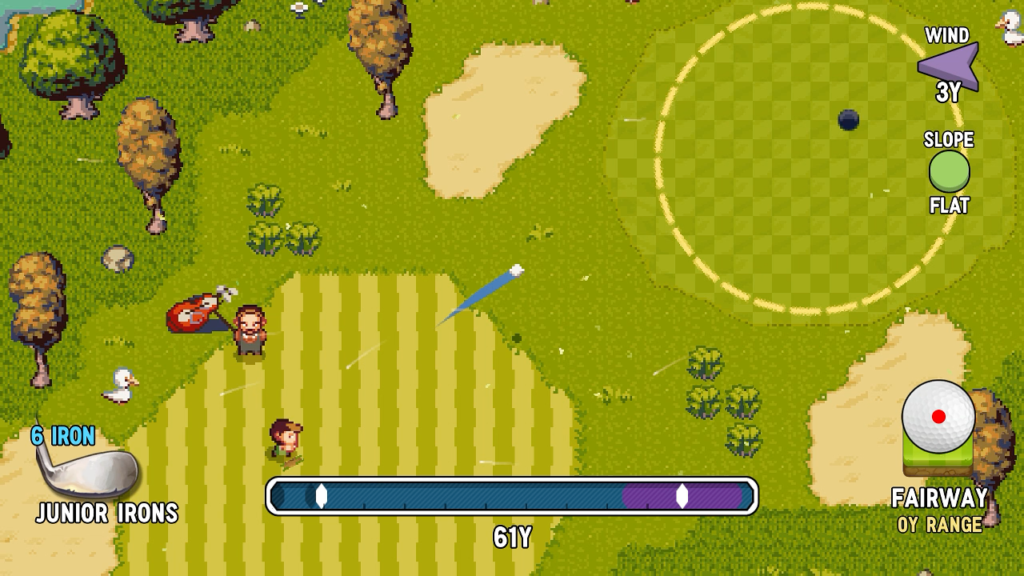
Golf Story’s main draw is that it applies familiar RPG systems—earning experience points and developing statistics that govern how the player character performs—to a golf-focused sports comedy. When the protagonist visits one of the world’s golf courses, I can explore a small sandbox filled with quests and activities that somehow always culminate in knocking a sphere into a hole. Some of these quests are straightforward goals given to the protagonist by a non-player character. Others are more esoteric and require independent exploration, such as the rainbow-ringed hole hidden in each sandbox. I can tee off from almost any location, driving my ball into the distant edges of the map to discover secrets I cannot simply walk to.
Whether I complete a quest or sink a ball into a secret hole, when I complete a goal I earn experience points. If I earn enough experience points, I earn a level up and can put five stat points into statistics that improve my various golf skills. I can make my ball fly straighter, increase my shots’ accuracy, or increase the distance my drives can send the ball. With enough points pumped into the protagonist’s Power statistic, I can easily reach the green in two strokes on a Par 5, setting myself up for a coveted Eagle, or two under par for the course.

The protagonist’s aspirations to grow from amateur to pro takes them across eight different courses. His journey begins in Wellworn Grove, the course where he learned to golf from his father as a child. Years of neglect under a criminally suspicious owner have transformed its lush fairways and respectable local players into unkempt lawns populated by a rowdy, uncouth rabble. Once establishing this unsavory course as his home base, the protagonist builds their reputation by competing on rival courses. There’s Bermuda Islands, a trendy resort with tiny islands instead of rolling fairways. Tidy Park, a once-legendary course run by old pros where both have gone to seed. And Coldwind Wastes, a desolate course built into a frigid mountainscape.
I only wish these settings embraced the fantastic that Golf Story’s premise—and its marketing—suggest. Lurker Valley is a primordial course filled with tar pits, dinosaur bones, and players dressed in leopard print loincloths. Oak Manor is a macabre course decorated with jack-o-lanterns, gothic fencing, and surrounded by a graveyard haunted by actual ghosts. The remaining six courses, while impractical as real-world courses, still feel grounded in reality.

I am disappointed Golf Story does not take advantage of its genre and medium to truly explore a supernatural setting outside of a few of its most memorable sidequests. Worse still, when I leave any course’s introductory sandbox to play an actual round of golf then even Lurker Valley and Oak Manor’s supernatural elements become a mere aesthetic overlaid on unremarkable videogame golf.
Despite each setting serving more as aesthetic than theme, Golf Story’s courses aren’t without creative mechanics. Wellworn Grove’s mismanaged course is infested with moles who move the ball behind obstacles and into sandtraps if I shoot too close to them. Coldwind Wastes is filled with ice that causes my ball to roll a long way across fairways—a long way. After befriending a turtle bale, they use their shells to bounce my ball away from water hazards in Lurker Valley.
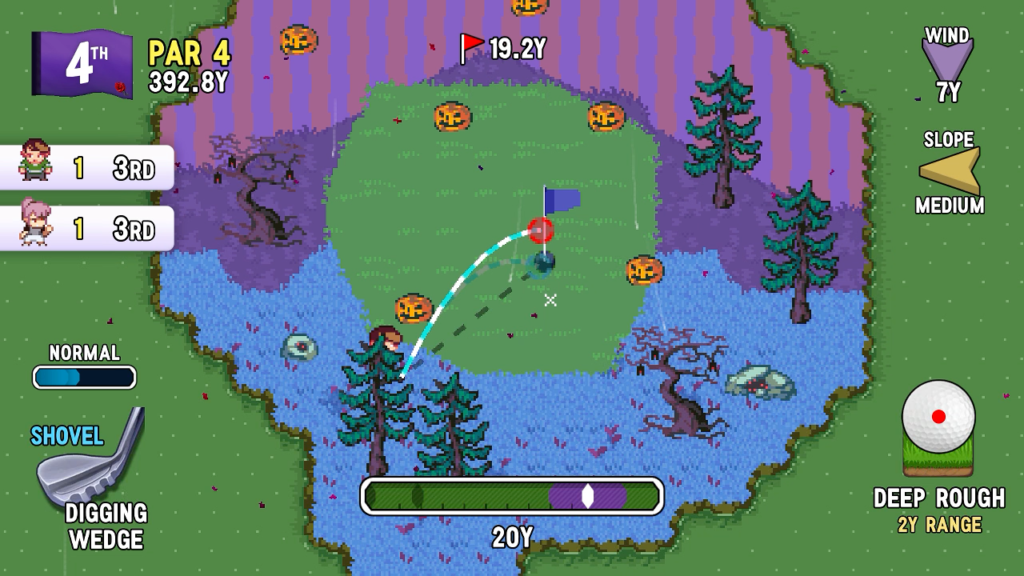
These gimmicks make the courses they affect more memorable, but disappointingly not every course has one. I can accept that the stuffy pros of the Blue Moon Dunes will not accept any wackiness when they host a prestigious pro tournament, but when the most unusual obstacle in the haunted Oak Grove course are jack-o-lanterns dotting the fairways, something just feels missing. More disappointing is that each course consists of a mere nine holes instead of the standard eighteen. To an old hand at either real or videogame golf, Golf Story’s courses feel literally half-finished.
Experienced videogame golfers will feel right at home with Golf Story’s golfing mechanics. Played from a top-down view, I can shoot the ball in any direction. With the press of the action button, a cursor at the screen’s bottom moves to the end of a meter as the protagonist begins their swing. Pressing the button again will set the shot’s distance and send the cursor back to its origin. A third button press determines the shot’s accuracy; the closer I stop the cursor to the meter’s beginning, the straighter my shot will travel.
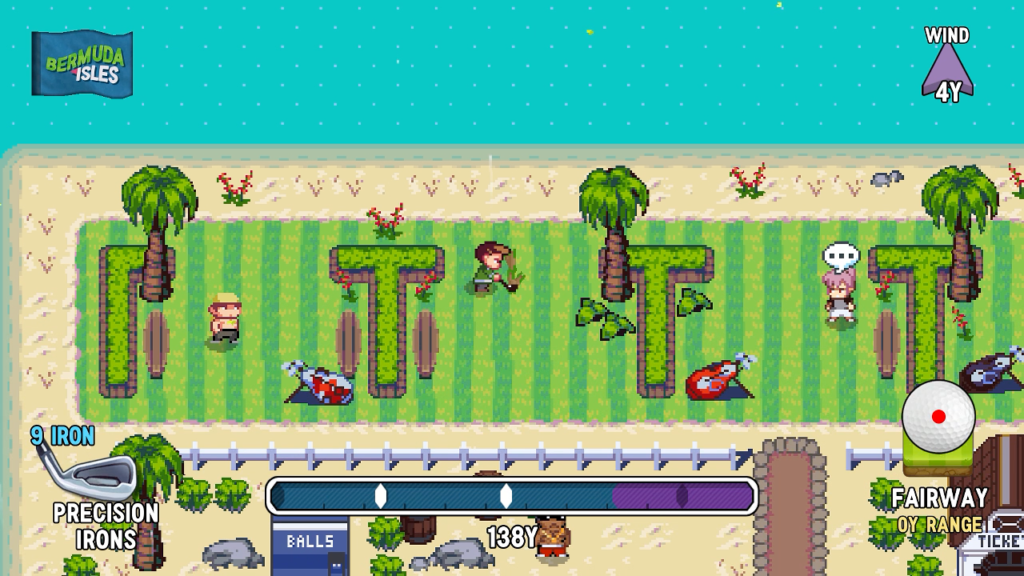
Before I begin my swing I can make many choices that also affect my shot. I can switch between clubs to change its distance and loft. I can set a target on the power meter for a precision drive. I can adjust where I will strike the ball to make it spin around obstacles or fight against a headwind. It’s all typical videogame golfing stuff and a player familiar with most other golf videogames will feel right at home here.
This isn’t to say that Golf Story is easy. It has several interface problems that can make it difficult to make par. Foremost is the targeting reticle is downright misleading about where the ball will land. Regardless of considerations like terrain, wind, or slope, the ball always lands further than where I set the targeting reticle. Always. Significantly under-targeting my shots is practically a requirement to keep balls out of traps.
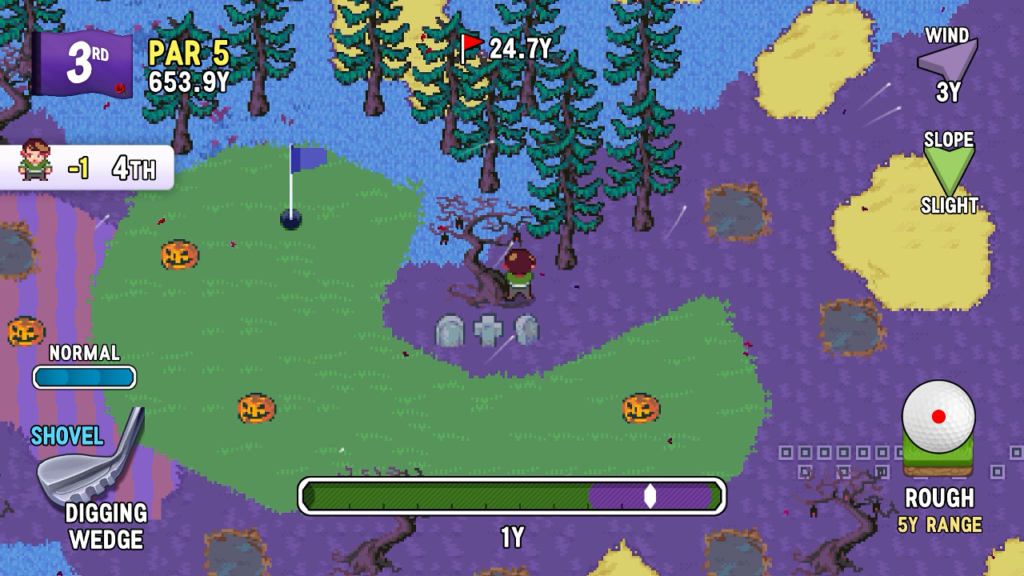
Also annoying is the fixed top-down view makes getting out from behind an obstacle difficult. Because I am unable to get up close with an offending object, I can’t see how to adjust my shot to curve around it. Usually when I do find a way to target the ball so the reticle aims past it, the ball ends up hitting the object anyway. In moments where my ball ends up hugging against an obstacle, I either have to hit back in the direction I came just to get away from it, or else start the entire challenge over from the beginning.
Whether I am aiming for a narrow fairway patch or working around a stubborn obstacle, these targeting issues demand careful play to succeed.
Playing it safe isn’t really a problem, however, given Golf Story’s scripted nature. Every competition the protagonist enters already has a pre-determined outcome for its non-player characters. Lucky will always score a +1 in the Wellworn Grove Open, so I only need to make Par on the course to win. Lara will always make a hole-in-one on Oak Manor’s first hole in her Match Play challenge, but her game will also always break down in the course’s back half, giving me a chance to catch up. Golf Story isn’t easy, but it is easy to know what will happen next: The same thing that happened the last time I tried.
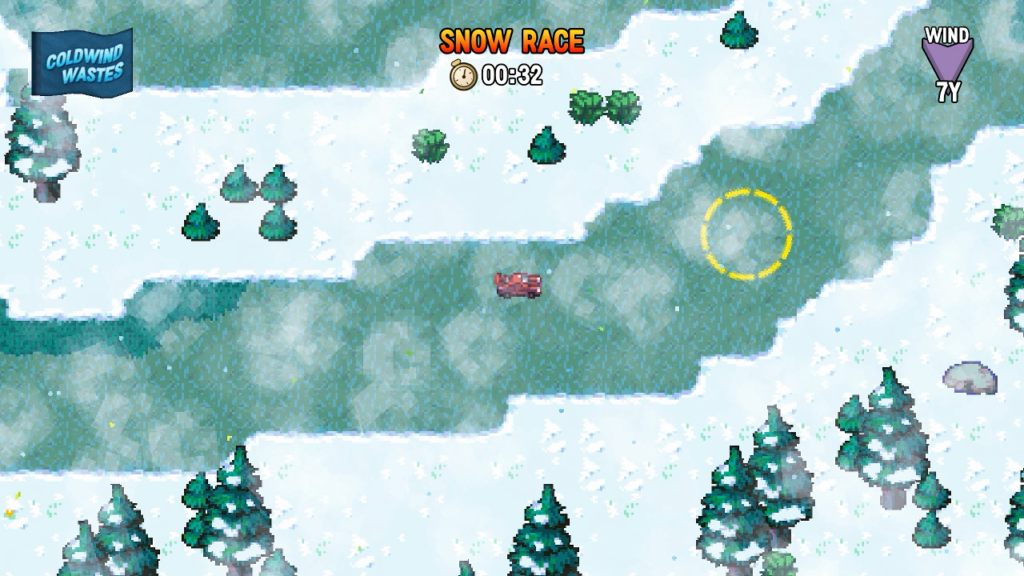
When not golfing I can participate in minigames that try to justify their presence in Golf Story by adding “golf” to their names. I’m not throwing a frisbee across an obstacle course into a chain basket, I’m playing disc golf. I’m not flying a drone to drop a ball into a hole—it’s drone golf. I can even uncover vintage cartridges for an in-universe videogame called Galf, based on Nintendo’s NES Golf videogame, one of Golf Story’s main design inspirations. All of these diversions have a steep learning curve, last only minutes, and contribute nothing to the experience. I resented every moment I spent playing them instead of further refining the skills I would actually use in the next tournament.
As a story, and particularly as a comedy, Golf Story often flails. A few moments do make me chuckle. Wellworn Grove has a high-tech “golf simulator,” which turns out to be a teenage boy in a small room who is either a mathematical genius or just makes up numbers while players pelt the wall with practice swings. Max Yards, the main villain, wins a trophy in spite of losing the tournament because everyone assumed he would win and his name was pre-engraved on it. In probably the most infamous moment, the Tidy Park retirees fight the Wellworn Grove punks in a rap battle, which manages to be funny mostly for how inexplicable it is.

Most of the time Golf Story aspires to bad sitcom humor. One extended scene tries to mine humor out of the protagonist’s golf coach trying to cook a pot roast in a microwave while keeping his date oblivious and occupied. Men only knowing how to cook with microwaves is a running gag, in fact. The protagonist’s ex-wife follows him to a competition, loudly questions his ability, then claims a cut of his winnings as alimony. There’s an underlying assumption that people being selfish and incompetent is inherently funny, when really it’s just a chore to endure.
I’ve already lamented that Golf Story only flirts with its sparse fantasy elements. Now I further lament that teen necromancers who plan to take over rival courses using a skeleton army being thwarted by a golfer using explosive balls is one of the funniest events I encounter, and the story barely seems aware that it’s funny. It’s when Golf Story is being accidentally surreal that it’s at its best, but it doesn’t know how to lean into that strength.

As a golf RPG, Golf Story has a lot of promise. The small sandboxes where I can tee off from literally anywhere to complete activities are engaging and I would be happy to play an entire sequel’s worth of them. While it’s disappointing that there are only nine holes on each course, these courses do have unique identities offering distinct challenges. Some of the golfing mechanics are imperfect, but making safe choices and practicing restraint makes them easy to overcome. It’s everything else built around Golf Story that can make it frustrating. It sometimes detours into non-golfing activities that aren’t fun and don’t add anything meaningful. Worst of all, as a story it doesn’t draw me in and only occasionally entertains me. There’s potential for a great golf videogame filled with fantasy and whimsy, but that potential is unfulfilled.